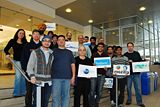Difference between revisions of "XB PointStream"
| Line 15: | Line 15: | ||
[[File:Multishells.png|center|300px]] | [[File:Multishells.png|center|300px]] | ||
| + | |||
| + | |} | ||
| + | |} | ||
| + | |||
| + | <!-- LEFT-HAND COLUMN --> | ||
| + | {| id="mp-upper" style="margin:0 0 0 0; background:none;" | ||
| + | <!-- |colspan="3"|<div style="background: #ffff00">'''Important!''' - The [[CDOT Development Systems]] have been re-arranged .</div> | ||
| + | |- --> | ||
| + | | class="MainPageBG" style="width:55%; border:1px solid #ccc; background:#f8f8f8; vertical-align:top; color:#000;"| | ||
| + | {| id="mp-left" cellpadding="2" cellspacing="5" style="width:100%; vertical-align:top; background:#f8f8f8;" | ||
| + | ! <h2 id="mp-tfa-h2" style="margin:0; background:#b51418; font-size:120%; font-weight:bold; border:1px solid #ccc; text-align:left; color:#fff; padding:0.2em 0.4em;">About CDOT</h2> | ||
| + | |- | ||
| + | | style="color:#000;" | [[File:Cdot-group-shot-1-20091.jpg|border|right|160px]]<div id="mp-tfa">The typical method used to represent 3D graphics for applications such as video games is that of a textured meshed. Essentially the object is made up of a mesh of flat triangles and a 2D texture graphic that is applied over the mesh to give it its colour and depth. However, this is not the only way to represent 3D graphics. Another method for representing 3D graphics is that of a point cloud which is a set of coloured points in 3D space. While a point cloud is usually larger than a textured mesh in terms of amount of data, it provides a level of realism not found in a mesh. Furthermore, some 3D scanning equipment such as 3D scanners, LiDAR equipment, medical scanners, and MicroSoft's Kinect all deliver their data as point clouds.</div> | ||
| + | |- | ||
| + | ! <h2 id="mp-dyk-h2" style="margin:0; background:#b51418; font-size:120%; font-weight:bold; border:1px solid #ccc; text-align:left; color:#fff; padding:0.2em 0.4em;">Events</h2> | ||
| + | |- | ||
| + | | style="color:#000;" | <div id="mp-dyk">{{CDOT Current Events}} | ||
| + | |||
| + | '''Past Events:''' | ||
| + | * See [[Special Events History]] | ||
| + | </div> | ||
| + | |} | ||
| + | | style="border:1px solid transparent;" | | ||
| + | <!-- Right-hand column --> | ||
| + | | class="MainPageBG" style="width:45%; border:1px solid #ccc; background:#f8f8f8; vertical-align:top;"| | ||
| + | {| id="mp-right" cellpadding="2" cellspacing="5" style="width:100%; vertical-align:top; background:#f8f8f8;" | ||
| + | ! <h2 id="mp-itn-h2" style="margin:0; background:#b51418; font-size:120%; font-weight:bold; border:1px solid #ccc; text-align:left; color:#fff; padding:0.2em 0.4em;">Current Blog Posts</h2> | ||
| + | |- | ||
| + | | style="color:#000;" | <div id="mp-itn"> | ||
| + | <!-- {{Planet Current Posts}} --><rss>http://zenit.senecac.on.ca/~chris.tyler/planet/rss20.xml|short|max=18</rss> | ||
| + | '''See more posts on [http://zenit.senecac.on.ca/~chris.tyler/planet/ Planet CDOT].'''<br /> | ||
| + | You can add your own blog to the [[Planet CDOT Feed List|Planet List]]. | ||
| + | </div> | ||
| + | |||
| + | |} | ||
| + | |} | ||
| + | |||
| + | {| id="mp-topbanner2" style="width:100%; margin-top:1.2em; border:none;" | ||
| + | | style="width:88%; | | ||
| + | {| style="width: 100%; border:none; background:none;" | ||
| + | | style="text-align:center; color:#000;" | | ||
| + | <center>[[Image:C3dl-logo.png|120px|link=http://c3dl.org]] [[Image:Eclipse-logo.jpg|120px|link=http://eclipse.org]] [[Image:Fedora-logo.png|120px|link=http://fedoraproject.org]] [[Image:Powered_by_mozilla.jpg|120px|link=http://mozilla.org]] [[Image:PjsLogo.png|150px|link=http://processingjs.org/]] [[Image:Openofficeorg-logo.png|120px|link=http://openoffice.org]]</center> | ||
| + | |||
| + | |} | ||
| + | <!-- PORTAL LIST ON RIGHT-HAND SIDE --> | ||
| + | | style="width:11%; font-size:95%;" | | ||
| + | | style="width:11%; font-size:95%;" | | ||
| + | |} | ||
| + | |||
| + | __NOTOC__ __NOEDITSECTION__ | ||
| + | |||
| + | <!-- ######### | ||
| + | |||
| + | |||
| + | NOTE: To edit current events, go to the page: [[Template:CDOT Current Events]] | ||
| + | |||
| + | |||
| + | ######### --><!-- Style borrowed from Wikipedia's front page --><!-- Main title is suppressed by a CSS entry in the page: MediaWiki:Monobook.css --><!-- BANNER ACROSS TOP OF PAGE -->{| id="mp-topbanner" style="width:100%; background:#fcfcfc; margin-top:1.2em; border:1px solid #ccc;" | ||
| + | | style="width:88%; color:#000;" | | ||
| + | {| style="width: 100%; border:none; background:none;" | ||
| + | | style="text-align:center; color:#000;" | | ||
|} | |} | ||
Revision as of 14:08, 17 May 2011
|
|
|
|
|
|
|
|



